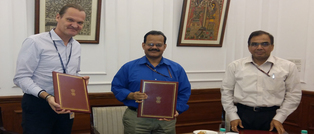Government of India and World Bank Sign US$ 300 million
 The Government of India, the Government of Madhya Pradesh and the World Bank today signed a US$ 300 million credit agreement for the Madhya Pradesh (MP) Higher Education Quality Improvement Project to improve student learning outcomes in select government-run higher education institutions in Madhya Pradesh, particularly for the disadvantaged groups. The project will also help increase the overall effectiveness of the higher education system in Madhya Pradesh.
The Government of India, the Government of Madhya Pradesh and the World Bank today signed a US$ 300 million credit agreement for the Madhya Pradesh (MP) Higher Education Quality Improvement Project to improve student learning outcomes in select government-run higher education institutions in Madhya Pradesh, particularly for the disadvantaged groups. The project will also help increase the overall effectiveness of the higher education system in Madhya Pradesh.
The credit agreement for the project was signed by Raj Kumar, Joint Secretary, Department of Economic Affairs on behalf of the Government of India; K K Singh, Principal Secretary, Department of Higher Education, on behalf of the Government of Madhya Pradesh; and Onno Ruhl, World Bank Country Director, India on behalf of the World Bank.
“The focus on improving higher education will not only help MP accelerate its social and economic development but also exemplify the Government of India’s thrust on increasing the supply of high skilled workers to drive the economy,” said Raj Kumar, Joint Secretary, Department of Economic Affairs, Ministry of Finance, Government of India.
Higher education in India has expanded rapidly. Enrollment has more than doubled from 8.4 million students in 2001 to 17 million students in 2011. Of these, nearly 10 percent or 1.6 million higher education students are enrolled in university or colleges in Madhya Pradesh. While the state’s Gross Enrollment Ratio (GER) of 19.5 in higher education is close to the national average of 21.1 percent, in the age group 18 to 23 years, only 13.1 percent of scheduled caste students and 7.5 percent of scheduled tribe students are enrolled in higher education. There are major concerns over quality too. A recent World Bank study finds that employers are most likely to reject newly graduated engineers for poor technical skills. Over 77 percent of employers in MP said weak technical skills was the most important reason for rejecting a job applicant.
“The project will support the implementation of the Government of Madhya Pradesh’s vision for the higher education sector and focus on improving the quality of learning, employability and research in higher education institutions in Madhya Pradesh,” said K K Singh, Principal Secretary, Department of Higher Education, Government of Madhya Pradesh.
About 3.6 million students, 10,800 academic staff and 1,400 administrators and officers in nearly 200 government colleges and universities are expected to directly benefit from the project.
“By focusing on good quality education for higher learning, extending scholarships to disadvantaged students, and improving resources available for teaching, learning and research, we hope the project will help produce a labor force that has the required skills and knowledge to boost the state’s economy and lift many out of poverty,” said Onno Ruhl, World Bank Country Director in India.
The main thrust of the project will be to help government colleges and universities to effectively use institutional grants in improving the quality of higher education, provide equitable access to education for all and ensure better capacity utilization, as well as include activities aimed at making students more employable. The project will also help create Centers of Excellence in select colleges and university departments to prepare best practice teaching-learning and research in a particular area.
Other strategic interventions of the project are to provide financial support to disadvantaged and meritorious students through scholarships; upgrade qualifications and skills of new and existing faculty members through a state institute for higher education training and research; and extend technical assistance to government-run higher education institutions to gain accreditation with the National Assessment and Accreditation Council (NAAC). The project will also strengthen the governance structures of government colleges with clear mandates on governance and accountability.
A 2012 World Bank report, ‘Madhya Pradesh Higher Education Reforms: Policy Options’ has identified access, equity and low quality as core challenges for the state.
Only about half of an incoming cohort of students graduate at the end of three years, and an even smaller percentage of students find employment. Transition rates of students from one year to the next, especially those from disadvantaged backgrounds, are low, with the drop-out rate being the highest between the first and the second years of study. Institutions are small in size, with average enrollment at 609 students (all-India average is 707), the study says.
“The project will enable colleges and universities to offer a better education to their students, to help them graduate on time and contribute to society. The reform path in higher education is long and complex, but Madhya Pradesh is a state ahead of many others in setting out on its reform path,” said Toby Linden, Lead Education Specialist and Sangeeta Goyal, World Bank’s Task Team Leaders for the project.
The credit is from the International Development Association (IDA) – the World Bank’s concessionary lending arm with a maturity of 25 years, including a 5 year grace period.

